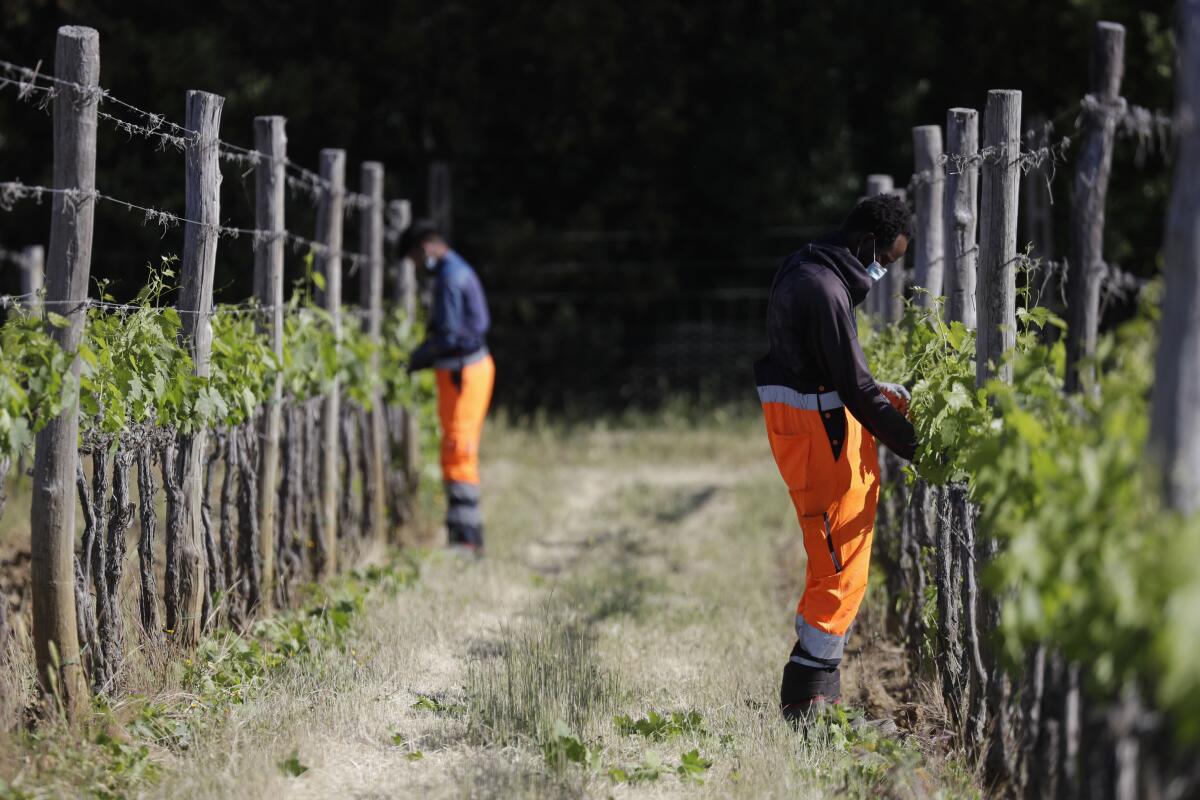Asylum-seekers help produce Italy’s famous Brunello wine

CASALE DEL BOSCO, Italy — Summer is arriving in Italy’s wine country in Tuscany, and the leaves on the vines shimmer in gold and green.
Yahya Adams moves his gloves through the foliage, removing excess buds and shoots to make the vines stronger.
He’s among 24 asylum-seekers from Africa and Asia who are working in the vineyards of Tenute Silvio Nardi on this year’s crop of Brunello di Montalcino, one of Italy’s most famous wines.
They come from Ghana, Togo, Sierra Leone, Guinea Bissau, Pakistan and other countries, with no prior experience in wine-making. But they have found temporary work here through a local nonprofit group that helps asylum-seekers find legal employment in vineyards or olive groves while their claims are being processed.
Adams, a 21-year-old from Ghana, is enjoying learning the craft.
“I like to study how the plant grows and I want to improve in this job,” he said. “And one day, I could teach others who arrive how to do the work, how to manage the plants, everything.”
Adams left Ghana when he was just 14 to search for work abroad. He spent two years in Libya, a conflict-ridden North African country where many migrants hoping to reach Europe face abuse and extortion from ruthless human smugglers.
Adams said he was temporarily held in captivity in Libya and considered going home to Ghana before making it to Italy on a ship with 118 other migrants. After living in centers for unaccompanied minors, he tried to find work in Belgium, but returned to Italy, where he is now enrolled in the agricultural work program of the Cooperativa Agricola San Francesco.
The NGO aims to bring asylum-seekers into the labor market with the same pay and working conditions as Italians, keeping them away from the off-the-books system known as “caporalato,” in which migrant workers often get exploited. The phenomenon is widespread among seasonal workers in the agricultural sector, where almost 40% are hired irregularly, according to the Placido Rizzotto Observatory, a union watchdog group monitoring the infiltration of organized crime in agriculture.
“Some of them, they can tell you, for three or four years they worked in the black market, with no contract, nothing, so they did not exist. They didn’t have social security, nothing. Here they have a contract, there is hope,” said Salis Godje, who coordinates the program for Cooperativa Agricola San Francesco.
Godje, who came to Italy from Togo as a student and received a degree in economics, said the asylum-seekers selected for the program are given a training course to learn the basics of vineyard work. After that, they do three seasonal stints in the vineyard, pruning in the winter and summer and harvesting in the fall.
Nicola Peirce, the president of the NGO, said the workers are paid around 7 euros ($8.52) an hour and work eight hours a day, in line with Italian union requirements for agricultural work. Others who end up working irregularly often earn half as much while working longer hours.
The program is now in its second year at Tenute Silvio Nardi, a family-owned winemaker established in the 1950s in the hills of Casale del Bosco. It annually produces 210,000 bottles of wine made with Sangiovese grapes, including 160,000 bottles of Brunello di Montalcino, which is aged for five years before release.
The asylum-seekers work in teams of eight over 40 acres, pruning vines under the supervision of agronomist Vittorio Stringari.
“You need to have some patience in the beginning,” Stringari said. “Like with everyone who starts a new job, there is a phase of apprenticeship. But given that they are very motivated ... they very quickly fill the technical gap.”
Adams considers himself lucky to have a job that he likes and from which he earns enough to send some money to his family in Ghana.
“If I had this work in my country, I would not go anywhere,” he said.
More to Read
Sign up for Essential California
The most important California stories and recommendations in your inbox every morning.
You may occasionally receive promotional content from the Los Angeles Times.










